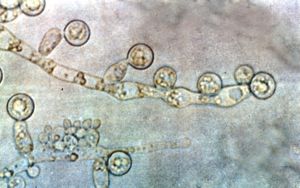Candida albicans: Difference between revisions
| Line 21: | Line 21: | ||
==Ecology and Pathogenesis== | ==Ecology and Pathogenesis== | ||
This microbe is found naturally in the human body, primarily in the intestines, colon, and mouth. It is normally commensal of humans but can be pathogenic if a person's immunity is lowered or there is a change in natural flora or physiology. It mostly attacks the skin or mucosae, but can also invade the lungs, blood, or heart in extreme episodes. Fluconazole is a popular treatment for systemic, oral, or vaginal infections; OTC treatments can also be used. Amphoterican B, applied intraveneously, is given to those with a severely weakened immune system [[#References | [1]]]. | This microbe is found naturally in the human body, primarily in the intestines, colon, and mouth. It is normally commensal of humans but can be pathogenic if a person's immunity is lowered or there is a change in natural flora or physiology. It mostly attacks the skin or mucosae, but can also invade the lungs, blood, or heart in extreme episodes. Fluconazole is a popular treatment for systemic, oral, or vaginal infections; OTC treatments can also be used. Amphoterican B, applied intraveneously, is given to those with a severely weakened immune system [[#References | [1]]]. | ||
==References== | ==References== | ||
Revision as of 05:16, 22 July 2013
Classification
Eukaryota; Opisthokonta; Fungi; Dikarya; Ascomycota; Saccharomycetes; Saccharomycetales; Saccharomycetaceae
Candida albicans
Description and Significance
C. albicans is a diploid fungus populating the human body, inhabiting 80% of everyone's intestinal tract, colon, and mouth with no problems. It is unusual in that it is polymorphic, meaning it can grow as both a yeast and as filamentous cells. It is a popular cause of oral ("thrush") and vaginal infections, but is easily treated with common anti-fungals in people who are not immunocompromised.
Structure, Metabolism, and Life Cycle
C. albicans can take on either a unicellular (yeast) or multicellular (hyphae, pseudohyphae) form. It can also create a biofilm. The form it takes depends on environmental cues.
The microbe is asexual, and does not perform meiosis. However, the diploids undergo parasex, meaning that diploid cells of opposite mating types (different from the characteristic male/female form) perform cell fusion to create a tetraploid. This unit then undergoes a split to return to a diploid state. While splitting, chromosomes are randomly lost. Chromosomes are not typically exchanged, though some gene conjugation does occur to provide genetic diversity [2]. For efficient mating, the microbes must switch from their white form (white and rounded cells forming dome-shaped colonies) to the opaque form (opaque, elongated cells forming a flatter colony). The opaque form is ~10E6 more efficient for mating than the white form [3]
Interesting features of its structure; how it gains energy (how it replicates, if virus); what important molecules it produces (if any), does it have an interesting life cycle?
Ecology and Pathogenesis
This microbe is found naturally in the human body, primarily in the intestines, colon, and mouth. It is normally commensal of humans but can be pathogenic if a person's immunity is lowered or there is a change in natural flora or physiology. It mostly attacks the skin or mucosae, but can also invade the lungs, blood, or heart in extreme episodes. Fluconazole is a popular treatment for systemic, oral, or vaginal infections; OTC treatments can also be used. Amphoterican B, applied intraveneously, is given to those with a severely weakened immune system [1].
References
[1] University of Maryland Medical Center, http://umm.edu/health/medical/altmed/condition/candidiasis
[2] Forche, A., Alby, K., Schaefer, D., Johnson A. D., Berman, J., and Bennett, R. "The Parasexual Cycle in Candida albicans Provides an Alternative Pathway to Meiosis for the Formation of Recombinant Strains", http://www.plosbiology.org/article/info%3Adoi%2F10.1371%2Fjournal.pbio.0060110
[3] Bennett, R., Johnson A. D. 2003. "Completion of a Parasexual Cycle in Candida albicans by Induced Chromosome Loss in Tetraploid Strains". The EMBO Journal. v. 22 (10); May 15, 2003. http://www.ncbi.nlm.nih.gov/pmc/articles/PMC155993/
[1] EXAMPLE ONLY. REPLACE WITH YOUR REFERENCES. Takai, K., Sugai, A., Itoh, T., and Horikoshi, K. 2000. "Palaeococcus ferrophilus gen. nov., sp. nov., a barophilic, hyperthermophilic archaeon from a deep-sea hydrothermal vent chimney". International Journal of Systematic and Evolutionary Microbiology. 50: 489-500. http://ijs.sgmjournals.org/cgi/reprint/50/2/489
Author
Page authored by Scott Foss, student of Mandy Brosnahan, Instructor at the University of Minnesota-Twin Cities, MICB 3301/3303: Biology of Microorganisms.

